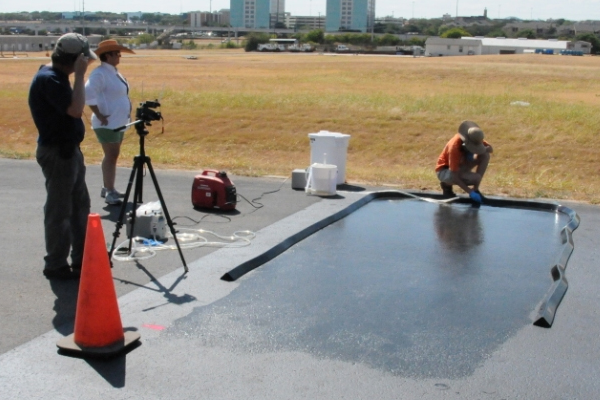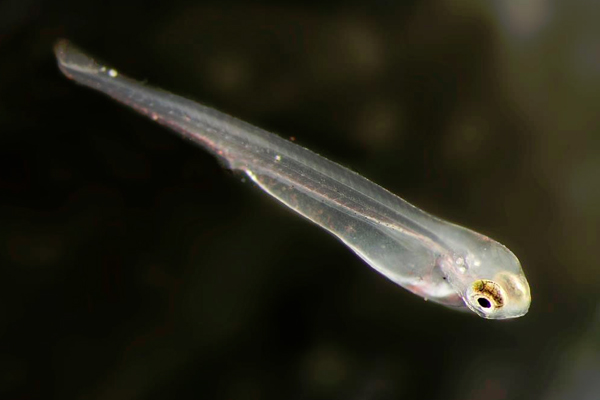USGS study finds that chemicals in runoff from coal tar sealed pavement are deadly to some aquatic life

Coal-tar-based sealants are commonly used to improve the resilience and appearance of privately owned playgrounds and parking lots. (Credit: USGS)
When people talk about streets that are tough, or deadly, they don’t usually mean the asphalt has it out for somebody. But for those living in the eastern U.S., the pavement beneath their feet may harbor chemicals capable of doing real harm to a variety of organisms. Two new studies from the U.S. Geological Survey show that rainwater runoff from pavement sealed with coal tar is highly toxic to aquatic life. Published in the journals Environmental Science and Technology and Science of the Total Environment, the studies illustrate that coal-tar-based sealant contains high concentrations of polycyclic aromatic hydrocarbons, and that those chemicals not only damage DNA, but also impair the process of DNA repair.
It’s hardly news that PAHs are toxic, says Barbara Mahler, a research hydrologist with the USGS and author of one of the studies. A century of research from various agencies, organizations and universities have determined that these chemicals are carcinogenic to humans. The USGS has spent a decade researching the effects of coal-tar-based sealcoat on the environment, and their new studies specifically target the effects of coal tar runoff on juvenile fish.
“What’s significant about this study is that we’re making the link now between the chemicals that we know are in the runoff and the actual biological effects,” Mahler said.
Coal tar sealants are refined from the byproduct of steel manufacturing in coking ovens, and the toxic chemicals within are created by the same process. PAHs are formed when certain compounds burn, and are often associated with forest fires and used motor oil. But coal-tar-based sealants contain PAH concentrations 100 times greater than used motor oil, and 1,000 times greater than those found in asphalt-based sealants, another popular pavement treatment.

USGS researchers collected runoff samples from pavement sealed with refined coal tar in Austin, Texas in 2011. (Credit: USGS)
For her study, Mahler and a team of researchers collected samples of runoff from parking lots that had been sealed with refined coal tar as recently as 5 hours prior and up to 111 days. For reference, sealant industry trade groups have suggested avoiding coal tar application if rain is expected within 24 to 48 hours. Using the samples to simulate rain water runoff, the researchers tested the survivability of fathead minnows and cladocerans — a tiny crustacean — after exposure to the contaminants in various levels of dilution
In the lab, the researchers placed the test organisms in undiluted runoff as well as runoff diluted with nine parts water. After 48 hours of exposure, the organisms were transferred to uncontaminated water and then exposed to four hours of ultraviolet radiation.
Less than 10 percent of the test organisms exposed to undiluted runoff from unsealed asphalt pavement died. Of the organisms exposed to runoff samples from coal tar sealed pavement between three and 36 days after application, however, 100 percent died prior to UV treatment. After being treated with UV radiation, all organisms died from runoff exposure, regardless of when the sample was collected.
Mahler said the organisms that died from exposure recently applied coal tar runoff were simply poisoned. However, deaths from phototoxicity — a mechanism by which PAHs absorb sunlight and release the energy into an organism’s cells, damaging DNA or the cell itself — were associated with runoff collected months after sealant application.

Hatchlings are particularly vulnerable to the phototoxic effects of PAHs due to their transparent skin. (Credit: USGS)
“Any aquatic life that hangs out near the surface is vulnerable,” Mahler said, noting amphibians and young fish in particular. “It’s really important for young hatchlings, because their bodies are very transparent.”
A related study, conducted in collaboration with a French research agency, further explored how PAH phototoxicity damages DNA. The study found that exposure to runoff diluted with up to 99 parts water caused DNA damage in the presence of UV radiation. Furthermore, the study revealed that PAHs not only damage the DNA within cells, but also hinder the cells’ ability to repair that damage.
“Every time you go out in the sun, your cells have DNA damage. But your cells have the ability to repair that,” Mahler said. “In a sense, exposure to this runoff is a double whammy to the cells.”
The risks of coal-tar-based sealant extend beyond the watershed and into the living room, Mahler said, as dust from sealed parking lots and driveways can be carried inside on the soles of shoes. Some cities have taken steps to limit or forbid the use of these sealants, but they’re still commonplace — especially considering the body of literature touting their toxicity.
In the U.S., it’s common to treat driveways, playgrounds and parking lots with pavement sealant to protect the asphalt below and improve its appearance. However, the preference for the type of sealant used is split so uncannily between east and west, it’s as though Americans have drawn a longitudinal Mason-Dixon line: Out west, asphalt-based sealant rules the roads; in the east, coal tar is the dominant sealant.
Mahler says that even in the East, however, coal tar sealants aren’t used on state-owned roads. Private businesses and organizations are the biggest users of the product, but that doesn’t mean they’re heartless citizens. A quick Google search illustrates the contention over the subject, returning websites such as TruthAboutCoalTar.com that attempt to disprove earlier studies about coal tar toxicity page by page.
Mahler declined to provide her thoughts on the future of coal tar as a pavement sealant, but she noted that the U.S. and Canada stand alone in its use — although a marketing effort is underway in China. Her job as a researcher, she said, is simply to provide the best information for policy makers and the public.
Top image: Coal-tar-based sealants are commonly used to improve the resilience and appearance of privately owned playgrounds and parking lots. (Credit: USGS)





0 comments